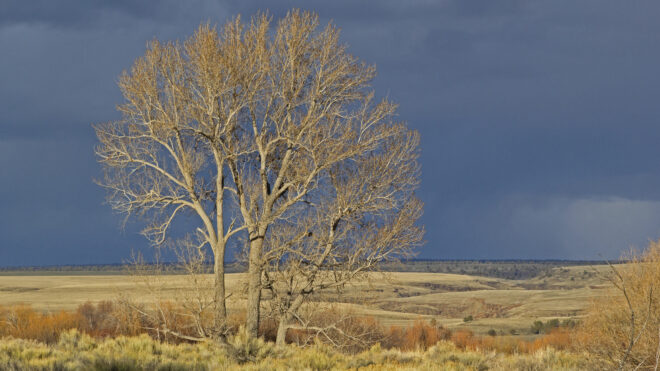Composer Chris Thomas is brilliant. He listened to the land and wrote a story in the form of an extraordinary symphony about a place. One day soon, I, along with Clay, am going to visit that place. For now I savor from afar and explore from home. The place: Malheur National Wildlife Refuge in southeastern Oregon.
This is a departure from our normal offerings on EarthWise and the Alabaster Horse, which will happen from time to time. In this piece, there are several web links and videos to view. I encourage you to take the time, not all at once if it suits, to look at them. The videos of the symphony are especially arresting. Not only do you get to hear the five movements of the symphony, accompanying the music are photos from Terry and Kay Steele Nature Photography. I am not going to go into great detail in writing about the refuge and the symphony, but allow you to discover it through the links provided.
Originally from Pendleton, Oregon, Chris Thomas has lived in California, then moved to Bend, Oregon. He was approached by Jay and Teresa Bowerman about composing a symphony commissioned through the Central Oregon Symphony Association, and the Malheur Symphony was born. Or I should say, the symphony was created. Chris Thomas took the essence of sounds and landscape at the Malheur Wildlife Refuge, listened and turned them into the notes we hear as a symphony.
Why am I intrigued by the Malheur Wildlife Refuge? I have seen small parts of the Malheur River. It draws me, and is beautiful in an ancient and captivating way. About a year and a half ago, Clay first told me of the symphony. The idea that a symphony could be written from a place and for a place lodged in my mind and would not leave. After an internet search, I found and listened to the symphony. The Malheur Symphony is evocative, exquisite and alluring. Ever since, I have wanted to see the Malheur land and feel it myself.
While I am out hiking the land, I rarely listen to music, which requires I use my iPhone out there. This is something I avoid, though I have it along solely to take photos. The sound is turned off and I ignore any notifications. This is my time. One day, not long ago, I decided to listen to the Malheur Symphony. Peering around to make sure no one saw me, I donned ear buds and luckily had enough cell reception to access the symphony. As I walked through hills with late summer cured bunch grass and juniper trees, I listened. Though some 170 miles north west from the refuge, the land I trod listened. The symphony composed by Chris Thomas connected me to this land, and the land he had written it for. It linked the place I walked and that place through an ancient pathway. Chris Thomas had tapped into the songlines of the land, indeed.
As you will find when you view the TED Talk and the Vimeo video, Chris Thomas went to the Malheur Wildlife Refuge with a sound engineer to record the voices of the landscape. In the commentator’s words from the Vimeo video, Chris Thomas “captured the sound cloud of the landscape and translated it into a meaningful menagerie of notes.” He then gathered up all the sounds, past, present and future and wrote the five movements of the symphony.
Malheur Symphony from Tim Wehde on Vimeo.
In the Vimeo video above, Chris Thomas speaks about composing the symphony. One of the instances he mentions is this: “I’ll leave just a small collection of notes in a little bubble and players can choose to play them very, like a flutist can play them very punchy and staccato-y just over and over, or play those exact same notes very mellow and legato and slow and everyone slowly trickles in in a section. There’s no tempo from the conductor. He just cues different sections whenever he feels like and begins to add to this cloud of sound”. I love this; the little bubbles of notes that can be played differently each time. This is how nature works. Nothing is ever the same twice. We also hear from the conductor, Michael Gesme. Another truly gifted artist.
The TED Talk is an intriguing illustration of Chris Thomas turning the songs of birds into musical notes, then melodies. It is utterly fascinating.
Here are the five movements of the Malheur Symphony in video form, complete with photographs from Terry and Kay Steele Nature Photography. Their photos are magnificent. The videos were produced by Kay and include an introduction and final message. I encourage you to read the information attached to each video. This can be accessed by opening the video in YouTube. Below, you will notice the icon in the upper right corner of the video link, with “1/7” underneath. This link includes an introduction, the five movements of the symphony, and a final message. By clicking on the “1/7” icon, you can see all seven selections, and either let them run from beginning to end, or choose particular ones.
A wealth of information about the Malheur National Wildlife Refuge can be found here: https://malheurfriends.org. There is also this site: https://www.fws.gov/refuge/Malheur/ from the U.S. Fish and Wildlife Service which is worth perusing, too. Also, check out the web site of Terry and Kay Steele Nature Photography. Their photos are superb, and you will find additional information about the Malheur National Wildlife Refuge and the symphony there. Be sure to look at their photo galleries and slideshows (I especially enjoyed the slideshow “The Coyote Den” because of the photos of coyote pups playing.) https://terrysteelenaturephotography.com
Several days ago, I sat upon boulder on the northeast side of the Butte of the Red Gold Rocks. Not a name you would find on a map, as I gave the butte my own name to better reflect who it is. As I wrote these words and thought of the symphony, I could feel it thrum through the land. The land listened again, too. I thought about how, when I listened to the symphony as I walked the land, each and every note seeped deep inside of me. The sound of the notes became a hum within that matched the thrum of the symphony through the bedrock of the land. And in those spaces between each note, I heard nothing yet everything.
“Sacred Basin” is my favorite movement of the Malheur Symphony, although I love all five movements. Let me know in the comments which is your favorite?
*The image of the tree and autumn landscape is from Adobe Stock, and is supposed to be from the Malheur National Wildlife Refuge. There was no photographer noted to credit.


Dear Jenny,
Tonight was the first time I could sit quietly and take some time to read your lovely blog. What a fascinating idea to write a symphony from a place…
I just listened to the first Vimeo and I am very intrigued. I’ll make time tomorrow to listen to the five movements.
Thank you for sharing Jenny, I think it’s going to make me see or hear, should I say, nature in a very different way. Xx
Jenny,
I sat down and listened to the TED talk.
I am deeply inspired! Thank you SO much for sharing!
If someone can compose a truly moving symphony from a wildlife refuge, I can write poetry from the wilderness living inside of me, right?!
It touched me deeply and I thank you for that.
Until then, lots of love to you x
Isabelle,
Hearing how the symphony has reached you is heartwarming:) Thank you for taking the time to watch/listen to the multimedia links. It is time consuming, but so worth it, as you have so eloquently noted. It has given me a new way to listen when I am out on the land, for sure. YES! Please write your poetry from the wildness living inside yourself. I am waiting with breath held to hear it❤️